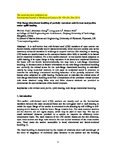Web-flange distortional buckling of partially restrained cold-formed steel purlins under uplift loading
| dc.contributor.author | Yuan, W-B | |
| dc.contributor.author | Cheng, Shanshan | |
| dc.contributor.author | Li, Long-yuan | |
| dc.contributor.author | Kim, Boksun | |
| dc.date.accessioned | 2018-03-05T18:16:22Z | |
| dc.date.available | 2018-03-05T18:16:22Z | |
| dc.date.issued | 2014-12 | |
| dc.identifier.issn | 0020-7403 | |
| dc.identifier.issn | 1879-2162 | |
| dc.identifier.uri | http://hdl.handle.net/10026.1/10966 | |
| dc.description.abstract |
It is well-known that cold-formed steel (CFS) members of open section can buckle locally, distortionally and/or lateral-torsionally. Since they are usually used as the secondary structural members in buildings to support roof and side cladding or sheeting, CFS beams are mostly treated as the restrained beams either fully or partially in its lateral and/or rotational directions. For a thin-walled channel- or zed-section beam subjected to uplift loading, if its upper flange is fully restrained in its lateral and rotational directions, the beam will not buckle lateral-torsionally, but may have a web-flange distortional buckling. In the literature there is limited information on the web-flange distortional buckling and currently the critical stress for the web-flange distortional buckling is calculated mainly by using numerical methods. In this paper an analytical model is presented to describe the web-flange distortional buckling behavior of the partially restrained CFS beams when subjected to uplift loading. Formula used to calculate the critical stress of web-flange distortional buckling is derived. Comparisons of the predicted critical stresses with those obtained using finite strip and finite element methods are provided to demonstrate the appropriateness of the model proposed. | |
| dc.format.extent | 476-481 | |
| dc.language | en | |
| dc.language.iso | en | |
| dc.publisher | Elsevier BV | |
| dc.subject | Cold-formed steel | |
| dc.subject | Purlin | |
| dc.subject | Uplift loading | |
| dc.subject | Web-flange distortional buckling | |
| dc.title | Web-flange distortional buckling of partially restrained cold-formed steel purlins under uplift loading | |
| dc.type | journal-article | |
| dc.type | Journal Article | |
| plymouth.author-url | https://www.webofscience.com/api/gateway?GWVersion=2&SrcApp=PARTNER_APP&SrcAuth=LinksAMR&KeyUT=WOS:000347580800044&DestLinkType=FullRecord&DestApp=ALL_WOS&UsrCustomerID=11bb513d99f797142bcfeffcc58ea008 | |
| plymouth.volume | 89 | |
| plymouth.publication-status | Published | |
| plymouth.journal | International Journal of Mechanical Sciences | |
| dc.identifier.doi | 10.1016/j.ijmecsci.2014.10.011 | |
| plymouth.organisational-group | /Plymouth | |
| plymouth.organisational-group | /Plymouth/Faculty of Science and Engineering | |
| plymouth.organisational-group | /Plymouth/Faculty of Science and Engineering/School of Engineering, Computing and Mathematics | |
| plymouth.organisational-group | /Plymouth/REF 2021 Researchers by UoA | |
| plymouth.organisational-group | /Plymouth/REF 2021 Researchers by UoA/UoA12 Engineering | |
| plymouth.organisational-group | /Plymouth/Research Groups | |
| plymouth.organisational-group | /Plymouth/Research Groups/Marine Institute | |
| plymouth.organisational-group | /Plymouth/Users by role | |
| plymouth.organisational-group | /Plymouth/Users by role/Academics | |
| dc.identifier.eissn | 1879-2162 | |
| dc.rights.embargoperiod | Not known | |
| rioxxterms.versionofrecord | 10.1016/j.ijmecsci.2014.10.011 | |
| rioxxterms.licenseref.uri | http://www.rioxx.net/licenses/all-rights-reserved | |
| rioxxterms.type | Journal Article/Review |


